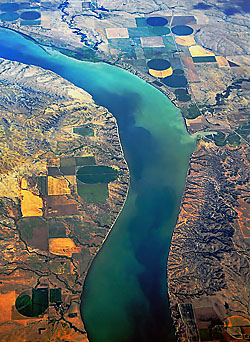 | The excess water being pumped into the Mississippi affects the ocean's acidity, say researchers. |
Midwestern farming has introduced the equivalent of five Connecticut Rivers
into the Mississippi River over the past 50 years and is adding more carbon
dioxide annually into its waters, according to a study published in Nature
by researchers at Yale and Louisiana State universities.
T H I S
Study: Farming is changing
chemistry of Mississippi River
“It’s like the discovery of a new large river being piped out of
the corn belt,” says Pete Raymond, lead author of the study and associate
professor of ecosystem ecology at the Yale School of Forestry & Environmental
Studies (F&ES). “Agricultural practices have significantly changed
the hydrology and chemistry of the Mississippi River.”
The researchers tracked changes in the levels of water and bicarbonate, which
forms when carbon dioxide in soil water dissolves rock minerals. Bicarbonate
plays an important, long-term role in absorbing atmospheric carbon dioxide,
a greenhouse gas. Oceans then absorb the excess carbon dioxide and become more
acidic in the process.
“Ocean acidification makes it more difficult for organisms to form hard
shells in coral reefs,” notes R. Eugene Turner, a co-author of the study
and a professor at the Coastal Ecology Institute at Louisiana State University.
The researchers concluded that farming practices such as liming, changes in tile
drainage, and crop type and rotation are responsible for the majority of the
increase in water and carbon dioxide in the Mississippi River, which is North
America’s largest river.
Raymond says that the research team analyzed 100-year-old data on the Mississippi
River, warehoused at two New Orleans water treatment plants, along with data
on precipitation and water export. “A notable finding is that changes in
farming practices are more important than changes in precipitation to the increase
in water being discharged into the river,” he says.
The researchers used their data to demonstrate the effects of excess water on
the carbon content of the river, and to argue that nutrients and pollution in
the water are altering the chemistry of the Gulf of Mexico.
The other authors of the study are Neung-Hwan Oh of F&ES and Whitney Broussard
of the Department of Oceanography and Coastal Sciences at Louisiana State University.
A grant from the National Science Foundation funded the research. W E E K ' S
W E E K ' S S T O R I E S
S T O R I E S![]()
 Study: Farming is changing chemistry of Mississippi River
Study: Farming is changing chemistry of Mississippi River![]()
![]()
 Pink is the new Yale blue for teams raising funds . . .
Pink is the new Yale blue for teams raising funds . . .![]()
![]()
 ‘Non-standard economist’ exploring motivations behind . . .
‘Non-standard economist’ exploring motivations behind . . .![]()
![]()
 Other SOM behavior research studies explore consumers’ . . .
Other SOM behavior research studies explore consumers’ . . .![]()
![]()
 Yale librarian and skater passes on her passion to local youngsters
Yale librarian and skater passes on her passion to local youngsters![]()
![]()
 In new role at Yale, art conservator will exhance campus programs
In new role at Yale, art conservator will exhance campus programs![]()
![]()
 Yale University Library starts the new year with staff changes
Yale University Library starts the new year with staff changes![]()
![]()
 Drawings by European ‘masters’ are featured in gallery exhibit
Drawings by European ‘masters’ are featured in gallery exhibit![]()
![]()
 Black History Month celebration features art, music and more
Black History Month celebration features art, music and more![]()
![]()
 Yale Opera will present ‘Die Fledermaus’
Yale Opera will present ‘Die Fledermaus’![]()
![]()
 Protection of cultural heritage is focus of ‘Iraq Beyond the Headlines’
Protection of cultural heritage is focus of ‘Iraq Beyond the Headlines’![]()
![]()
 In new exhibition, architects envision ‘a future that could have been’
In new exhibition, architects envision ‘a future that could have been’![]()
![]()
 Exhibition features unique gifts from around the globe
Exhibition features unique gifts from around the globe![]()
![]()
 It takes two
It takes two![]()
![]()
 First Yale BioHaven Entrepreneurship Seminar series event . . .
First Yale BioHaven Entrepreneurship Seminar series event . . .![]()
![]()
 Memorial service will be held in Dwight Chapel
Memorial service will be held in Dwight Chapel![]()
![]()
 Conversation on health care
Conversation on health care![]()
Bulletin Home |
| Visiting on Campus
Visiting on Campus |
| Calendar of Events
Calendar of Events |
| In the News
In the News![]()
Bulletin Board |
| Classified Ads
Classified Ads |
| Search Archives
Search Archives |
| Deadlines
Deadlines![]()
Bulletin Staff |
| Public Affairs
Public Affairs |
| News Releases
News Releases |
| E-Mail Us
E-Mail Us |
| Yale Home
Yale Home